Depthcrawl Design, pt 2 - Studying the Ancient Texts
14 August 2024
Note: This is part of a series! If you haven't yet, check out the first post over here.
Contents
Intro
Depthcrawls.
A quick recap of my previous post:
- the world needs more depthcrawls
- i will be the change i want to see
- borges good
- i want to make a city-themed crawl with three distinct ring-like layers
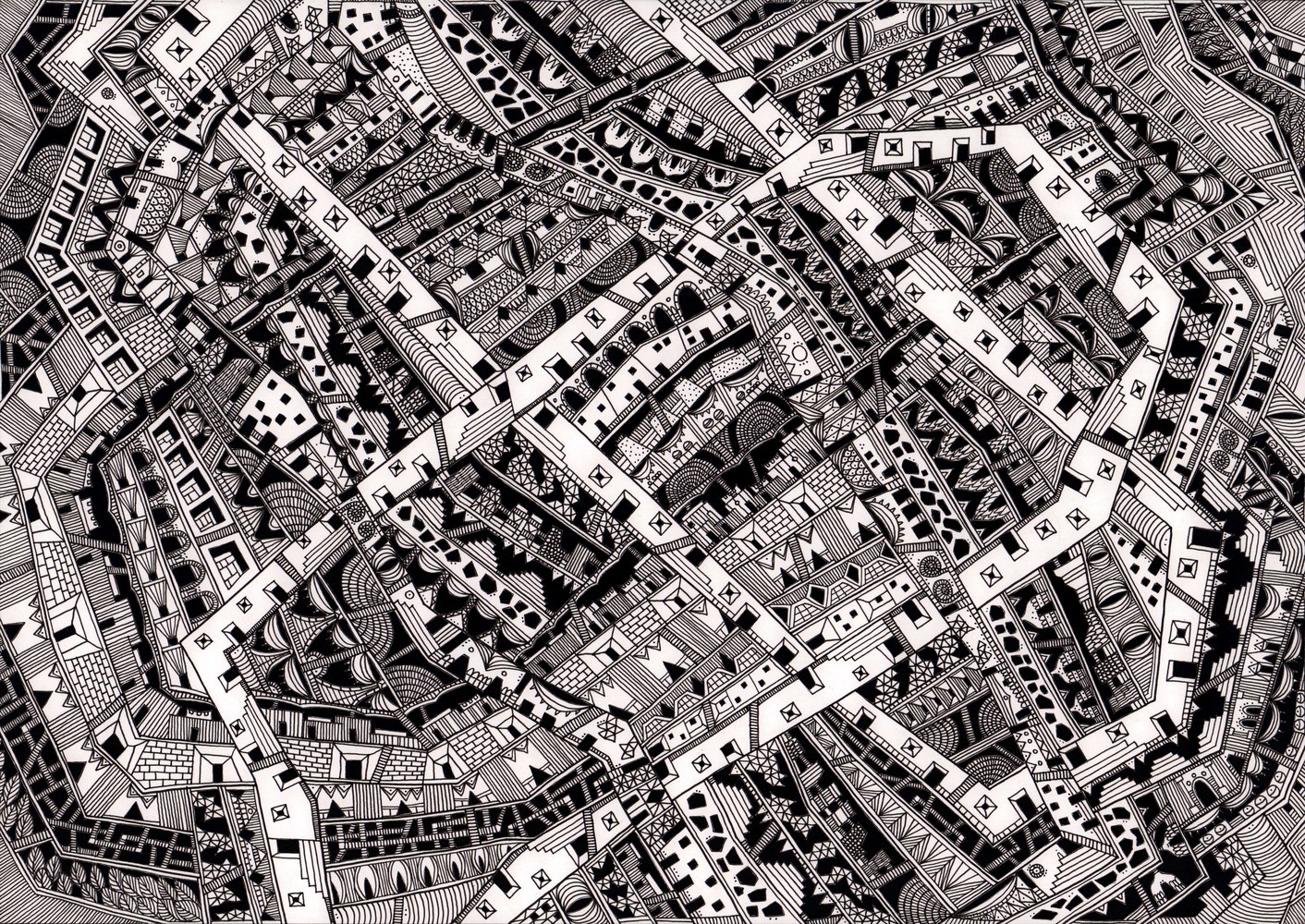
Per my roadmap, my next step is going to be a study of existing depth literature. Since posting I've read through the OGs: Gardens of Ynn and the Stygian Library, both by Emmy Allen. Let's get into it!
Case Study: Gardens of Ynn and the Stygian Library
Quick note: this isn't intended to be a review of either piece as a product. I don't have much to say there other than: they're great! You should buy them. Instead, I'll be sifting through the books, trying to understand what I can utilize moving forward while noting any major questions / design considerations that pop up.
This post is pretty long, so if you don't care about the nitty gritty and just want what I think are the most interesting bits, check out my thoughts on assimilation, layer generation and how dangerous I should make the crawl.
Setup
Ynn and the Library are both infinite, extradimensional spaces that constantly shift and change, making them impossible to map. Ynn is outdoors in an open air garden world; the Library contrasts (intentionally) by being entirely indoors.
What's critical here? Being in a pocket dimension obviously helps - I don't think it's strictly necessary but some amount of magic or reality suspension is definitely needed here. After reading Dice Goblin's great post on the four types of dungeon design, I don't feel it's a hot take to say the two must-have qualities are infinity and unknowability.
Or are they? Let's hash this out:
- if your space is infinite and unknowable, you've got a depthcrawl!
- if your space is infinite and knowable, you've got something like a procedural dungeon that is generated such that anyone who runs it produces the same results. Think: Minecraft seeds.
- if your space is finite and knowable, you've got a dungeon, pointcrawl, or maze / flux space.
- if your space is finite and unknowable... you... still have a depthcrawl!

Skeleton Code Machine's depthcrawl overview briefly mentions the Hull Breach supplement for Mothership, which includes rules for exploring an interstellar mega mart. I haven't read it, but per the post this space is randomly generated with typical depthcrawl rules until you produce the Exit location, at which point you pop out and can reset at depth 1. Technically endless in the sense that your exit is randomly determined, but I don't think infinity is the intention.
What matters is this: you can absolutely use depthcrawl procedures to explore a small, bounded space. How small can you be while still utilizing the mechanics well? Unclear! Is that what I want? Also unclear. I mean, Ynn and the Library both definitely aren't intended to be explored past the lower depths - at a certain point you just start generating the prose equivalent of "turn back now" signs. A question for later on, maybe, but worth keeping in mind.
Getting There
In Ynn, you have a ritual - find a wall covered in vegetation, use chalk and charcoal to draw a door, write a magic phrase. Leave and return. Voila: your doorway now opens into Ynn! Importantly, this doorway only remains for a full 24 hours, while the Ynnian day/night cycle lasts for 48 hours. Stick around for too long and you'll be trapped until you generate an exit.
Stygian is less about ritual, more about location: you must be in a library / book collection large enough that parts are hidden from the entrance, and somebody must have died there. Anything that meets these requirements has a permanent (if well-hidden) entry to the Stygian Library, so getting stuck inside is less of a concern.
Design Question: How do people reach The City?
DAMN if I don't love a good arcane ritual. The problem with my city setting isn't that I can't do this, it's that there are too many enticing options. My first thought is a driving-based method similar to one of my favorite spooky stories, the Left Right Game, but that's not the only thing that comes to mind.
Just spitballing:
- hitchhike on an empty highway under the right conditions (outfit, moon cycle, party composition)
- stay on the subway until the crowds are gone and the lights are off, then pay a special fare
- get a car and drive towards the sunrise for three days without stopping once. on the fourth morning, the sun will illuminate The City on the horizon.
- fall asleep in the house that is furthest away from the heart of a city while still technically being inside its limits. when you wake, it will be on the outskirts of The City.
I think I'll get a better feel for this ritual as I spend more time on the themes / vibes I want to work with on this project.
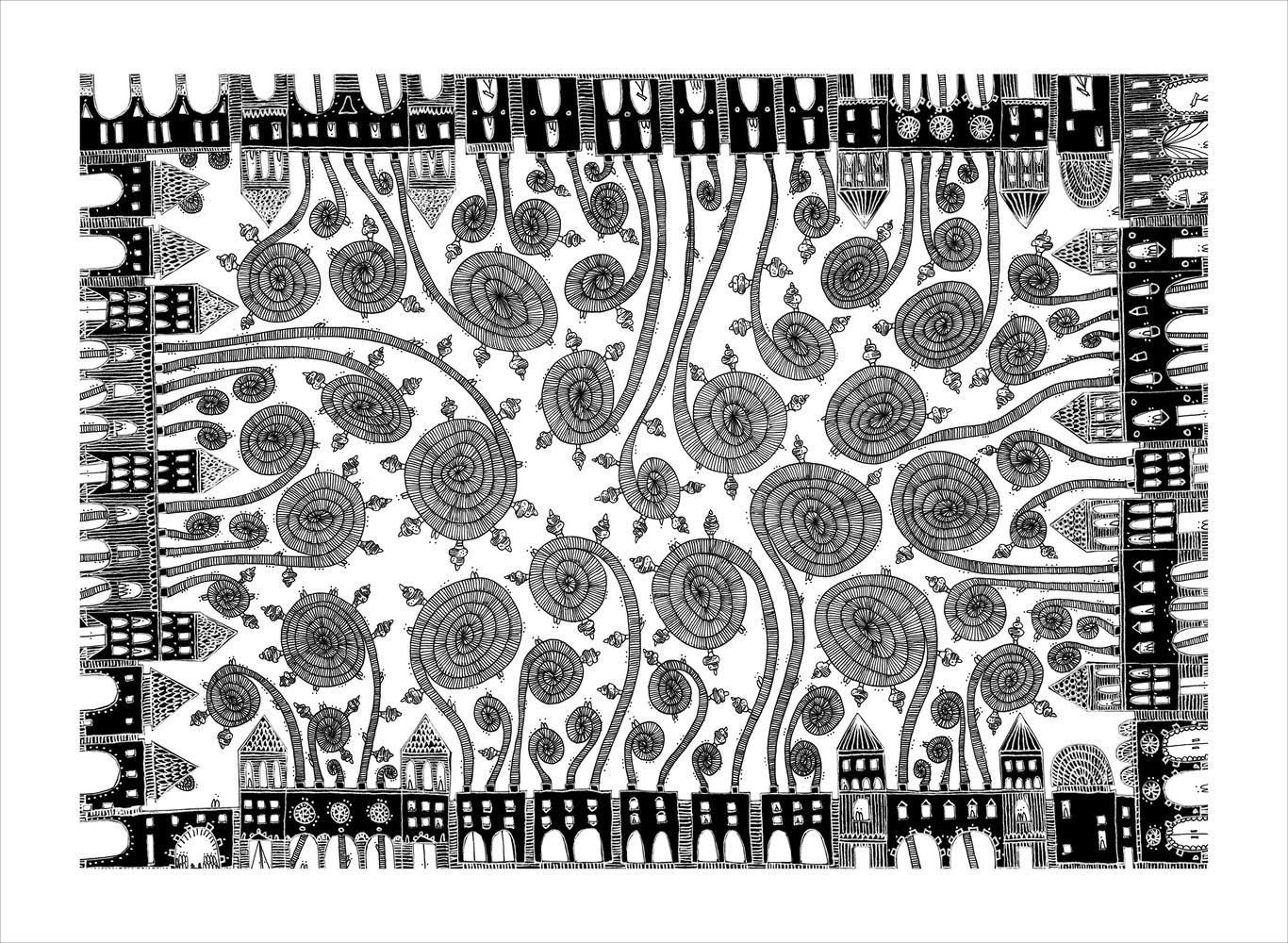
Hooks
Ynn has basic hooks, but nothing major. You inherited a mansion and your dead relative left notes to get inside! You chase a thief who escapes through a doorway into the garden! None of these have anything to do with the deep lore, and there's no well-known hidden treasure to find. Largely the book is presented just for the sake of exploring.
Stygian has a suggested main goal: finding information. If you're on the hunt for specific info, there's a Progress mechanic of scalable difficulty to represent your hunt through the library. Various locations and encounters interact with this mechanic, pushing you closer to or further from your goal. There are no other presented hooks (a good thing imo).
Design Question: Why go to The City?
There's a kind of dreamlike ideal to not offering any hooks and just saying that exploration is its own reward, but that's not appealing to me right now. Thinking back to my three-layered structure, a couple of possibilities comes to mind:
- each layer has its own reason to snoop around (unique treasure, macguffins, resource gathering, whatever).
- only the innermost layer has a "reward", and the journey is what's important.
- there's one consistent layer-spanning goal. maybe somebody wants to be escorted through the entire City in order to study something at each layer? maybe something needs to be collected in each layer in order to activate something special in the center?

Stygian's Progress mechanic isn't out of the question - it could be used in one specific layer, at least - but I don't think it's a good fit for the Big Hook. Personally I'm leaning towards something major in the center because it fits what I want to encourage the most: keep coming back, keep going deeper.
L O R E
Ynn was built by beautiful-extra-perfect-your-sweet-baby-OC-uwu-uber-elves called the Sidhe. It was intended as a wonderful pleasure dimension, but now it's off the leash and overrun by Creatures and artificial garden-tenders. The reason for this is that the Sidhe were infected by a memetic brain virus called The Idea of Thorns. Importantly: some Sidhe are still around, and they're still infected. The Idea is only encountered at low depths, but it's a real problem - there's a whole timeline for how it annihilates civilization if the players let it breach containment.
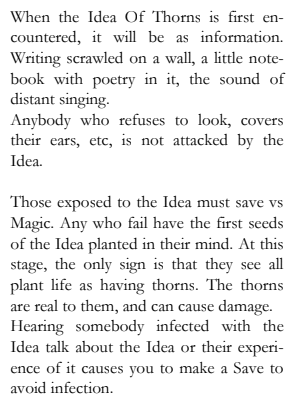
The Stygian Library, on the other hand, is alive and well. Its inhabitants are active, thriving, unbothered, in their lane, doing their shit. The major faction are librarians, stewards of the library doing research on something called the Great Avernian Calculation in order to reveal some grand universal truth. Souls, entropy, and the written words are their main focuses. It's also got an entrance to Hell! With devils! Probably those are unrelated :)
Unlike Ynn, the Library does not have some big Problem or Threat that can end the world if it gets out. Both locations are vast, alien, and unkind to intruders, but the Library is much less of an overtly hostile space (in more ways than one - we'll get to that!)
Design Question: Who lives in The City?
I think it's critical that The City is heavily populated, but by who? Humanoid entities? Former adventurers who died there? Artificial constructs?
The first thing I'm leaning towards is humanoids, but I'd like to take a page from Ynn's idea of infections and workshop something like an assimilation mechanic. The longer you stay in the city, the more you become assimilated (physical mutations? mental effects?). At a certain level of infection, you become a Citizen and leave the party to live in the City. I imagine the vast majority of the population are normal folks who settled here this way.

This opens up a few possibilities.
- Different layers can have different assimilation effects - maybe the most human NPCs are in the Suburbs, and things get less and less identifiable closer to center.
- Maybe assimilation can be a long, drawn out process - I'm imagining a meter that, every time you fill it up, causes you to add a new line to a hangman-like figure. Each line is a mutation, and when the figure's complete, you're gone.
- Some faction deep inside The City can be behind these effects, manipulating tourists for some alien purpose.
Movement
Both books have the same movement mechanics:
- Go Deeper to a new (or previously explored) location at the next depth
- Go Back to an already visited location
- Stay Here and risk an encounter
New paths to locations can be generated via encounters, but for the most part your map is going to look a bit like a finite state machine.
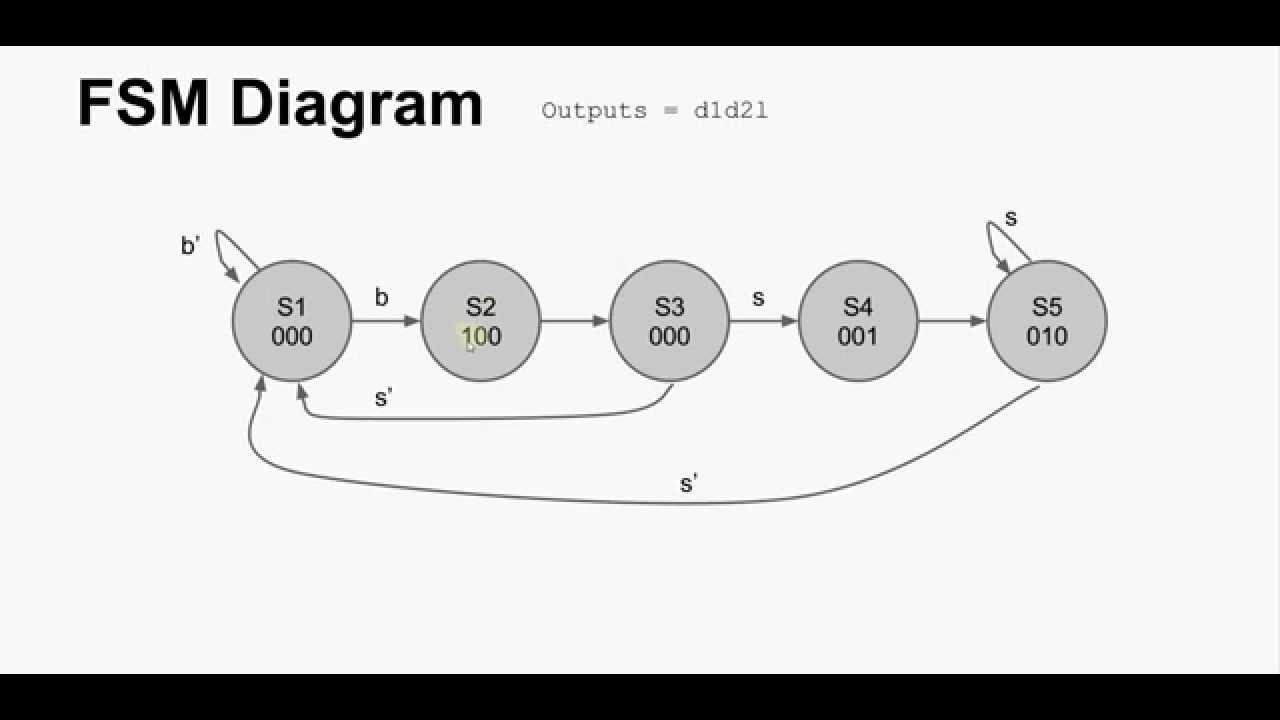
Design Question: What should we adjust here, if anything?

If I want to utilize this ring structure, I think the movement is a good spot to look. I posit a new move: Walk the Ring, which moves you clockwise (or counterclockwise) along the circle, generating a new location at the same depth. By itself this isn't very inspiring, but I think it opens up space for some interesting mechanics.
- cities can have roadblocks, preventing you from going deeper along the current path.
- different "slices" of the ring can be controlled by different factions, making it advantageous to strafe to a less hostile part of town before going deeper.
- it allows for cool rituals - "walk clockwise four times from The Basketball Court, and you'll always reach The Speakeasy"
This would necessarily modify Going Back to be more about moving away from the center of the ring. Depending on if you've been walking the ring or not, you may need to Go Back into unknown territory in order to leave The City.
Layer Generation
Both books use roughly the same method: roll 1d20+Depth for locations, details, and (when there are any) encounters. Where they differ is the overflow logic for results >=35.
- In Ynn, locations & details have a special, singular 35+ entry. Encounters are rerolled at 1d20+1d10+1d6-2.
- In the Library, locations are rerolled at 1d20+1d12+2. Details have a special entry. Encounters are rerolled the same way as Ynn.
In some ways the Library is a little more infinite than Ynn, because it re-uses most of the table rather than sticking you in the overflow slots. Depths 34+ in the gardens will only result in the combo Ruins of Ynn / Tangled Madness, whereas the Library has most of the locations table open to combo with the Tangled Passages detail (potentially a dead end, but still).
Design Question: Anything to add?
As far as The Algorithm goes, I do like Ynn's special overflow results because it feels like Minecraft's Far Lands. If I really want to allow for an infinite crawl, I could just use that 1d20+1d12+2 on both tables and call it a day. This gives an interesting opportunity for a special overflow result on the Encounter table - maybe something like Stephen King's Langoliers cleaning up anything that makes it too far out.

Re: overall procedure, I don't think I'd add anything but there's room for new flavor depending on what ring you're in. In the Suburbs you could be generating neighborhoods, in the City proper you could be exploring intersections, districts, or blocks. It's something to consider because I think A Structure or A Place of Interest could definitely work, but it might not be playing to the strengths of this large, densely settled space.
Design Question: How do we handle our ring setup with the depth mechanic?
This is a big one. I've got a couple different ideas.
First up: each ring gets bespoke location/detail/encounter tables. These could be smaller (1d12+depth), or I could go whole hog and have full 1d20 tables bc that's more exciting. I imagine transition between layers would have clear cutoffs, either by randomly generating a transition point (similar to the Hull Breach example earlier), or by reaching a certain depth. Ex: Depth 6 is the end of the Suburbs, and at Depth 7 you start rolling on all the City tables.
Alternatively: one huge table, smaller die. Certain areas on this table could be "melding points" - spots where the layers butt up and/or melt into each other.

I'm more immediately drawn to the second idea because I like the idea of exploring these border zones between layers, plus this idea of, like, you can go into the City proper and then take a wrong turn and end up closer to the Suburbs because the layout is just that disorienting. A relatable experience for a suburban child like me!
HOWEVER unless we have a truly huge table there aren't going to be that many possibilities within each layer, and I think a big draw of Emmy's work is the potential to roll something cool among a large set of options. If I give each layer, say, 7 slots on the table, plus 7 transition slots between layers, we get 35 slots total. That's the same as Emmy's tables, but each layer only has 14 possible options. Does that still give them opportunity to shine? Is it exciting to look at the Suburbs and see just 14 location options, only 7 of which are fully bespoke??

Or maybe we could mix these ideas: each layer gets larger unique tables, and higher/lower results are blended with the other layers as needed? Something to think about.
Locations
I really like working with ratios because my brain doesn't have enough wrinkles to just wing a design like this. So I went through these tables and categorized each entry into three broad boxes: Safe, Odd, and Harmful / Inconvenient. Safe and harmful are obvious, but Odd locations have weird, maybe-good-maybe-bad things to interact with. This is an art, not a science, and I had to go with gut feeling for several rooms.
For Ynn:
- Safe locations: 10 (lawn, vine, gazebo, statuary, shooting range, fountain, incubation beds, vivisection theatre, winery)
- Odd locations (can help or harm, interesting stuff to play with): 12 (herb, ponds, hothouses, orchids, chess, kennels, mausoleum, tower, cemetery, masks, settlements, vats)
- Harmful / inconvenient locations: 13 (orchard, rose, silk-garden, hedge, woods, shadow theatre, gears, firepit, cliff-garden, ice rink, mushroom beds, steam-pipes, electrodyne, ynnian ruins)
For the Library:
- Safe locations: 15 (auditorium, catalogue, chapel, display case, help desk, jarred brains, map gallery, mausoleum, mummy vault, printing machine, reading lounge, skeletons, statuary, stuffed animals, tea room)
- Odd locations: 14 (boiler room, calculation engine, chained lectern, dissection theatre, entrance foyer, furnace, holding pen, ink vats, ossuary, phantom databanks, phantom pumps, orrery, sheol, vault)
- Harmful / invonvenient locations: 5 (infernal gate, beehive, spider trapdoor, steam vents, syphon)
I'm glad I did this, because I don't think I clocked how much less dangerous the Library's locations are when I first found it. Ynn has roughly even ratios, but that doesn't tell the whole story, because what matters is where they are on the table. Adding depth to your rolls means you're not getting a flat distribution spread across the whole thing. Both books have their lower depths weighted with more dangerous entries, which makes sense - you want things to get tough the deeper you go.
Worth noting: Ynn has something that the Library doesn't, which is locations-within-locations! Hothouses/orchids, hedge mazes, towers, and ynnian ruins all have unique procedures to generate or explore them within an already roll-heavy adventure.

I understand why these maybe didn't show up in the Library - it's a lot to ask a referee to generate the adventure on the fly and then throw a bunch of dice on the table to create some greenhouses. But, wow, it's also so cool and adds a ton of flavor to the world. Since one of my goals is eventually automating these rolls with Twine, maybe I can lean into that by adding a few roll-heavy locations like these in and letting the Machine take care of the grunt work.
Details
Same story, different boxes: Flavor (aka safe), Beneficial, and Harmful / Inconvenient details.
Ynn:
- Flavor details: 15 (empty, graffiti, maintained, nests, rumbling, lamp-post, frames, birds, ivy-covered, singing, glass-roofed, clockwork parts, churning, fleshy, luminous)
- Beneficial details: 6 (treasure, corpses, silver, skeletons, fertile, doorway out)
- Harmful / inconvenient details: 14 (tubes, flooded, burned, frozen, inverted, floating, chasms, smouldering, predatory, entrancing, hypnotic, parasitic, tangled madness, zero-grav)
Stygian:
- Flavor: 12 (candles, candlesticks, empty, glass tubes, lamppost, graffiti, lamps, scrolls, spirit illumination, spirit tubes, stacked papers, time-locked)
- Possibly beneficial: 7 (doorway out, fireplace, funeral urns, treasure, letters, rug, treasure, webs)
- Possibly harmful / inconvenient: 16 (chained, gaslamps, haunted, morbid, no gravity, portcullis, semi-corporeal, silent, smoking, staircase, tangled, too large, too small, gears, inconvenient, watchful)
Once again, the tables are backloaded with the more dangerous options, although in this case Stygian has a little more teeth.
Design Question: Which distribution should I use?
Well for shiggles I wrote a quick Python script to simulate how likely you are to run into something dangerous according to my vibes-based calculations. Note: I'm only interested in overt good or bad results here. A beneficial location and harmful detail cancel out into Unclear in this script.

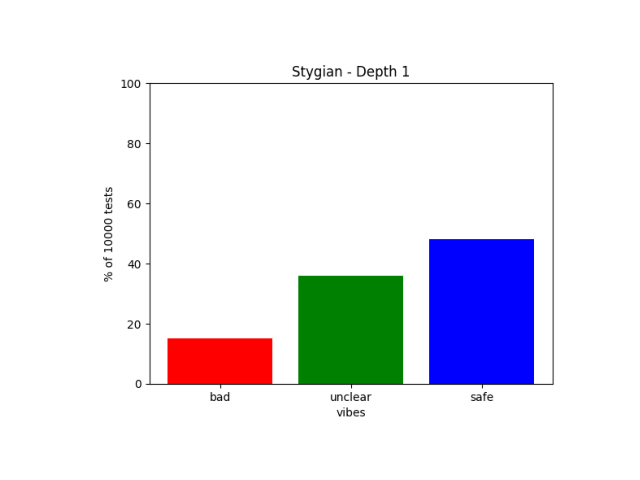
We can see that Ynn has hands out the gate while Stygian has less bite. My read is that the Library is really expecting most of the danger to come from encounters / reaction rolls, whereas Ynn hates you personally and wants your lunch money.
Personally I lean more towards Stygian's distribution, but, worth considering: different ratios for different layers. Maybe the Suburbs are safe on the surface, then turn vicious deeper in. Maybe the Manor frontloads its scariest parts, then quiets down and gets more dreamlike as you get past the guards.
Encounters
Both books have two separate encounter tables. Ynn's are separated by Day/Night, Stygian's by whether or not you've pissed off the librarians. Every entry is delicious, no misses, but Stygian is elevated by Alec Sorenson's amazing art.
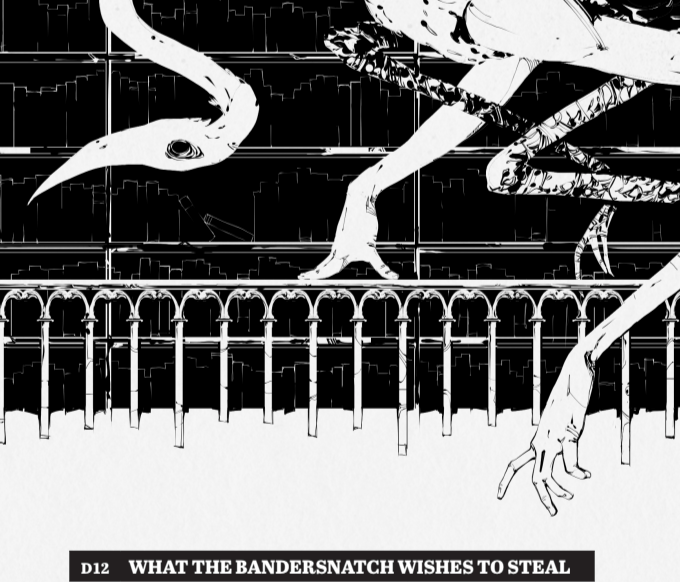
Something Ynn has that the Library doesn't: unique monsters! There's only one Jabberwocky, Questing Beast, Unicorn, and Worm - if they're dead, you reroll as lesser monsters. There's also the Idea of Thorns and the mindless remaining Sidhe, which are major issues in their own right.
Likewise, since the Library isn't a ruin, it has room for a bit of faction play. The Librarians, the Floating Brains, and the Neurovores all hate each other, giving you room to ally with one against the rest. Archivist Liches are dangerous in a fight but fully capable of helping you on your quest for information. Escaped Fictions are just weird and change the rules to fit whatever book they came from. It's all just so good I love table top role playing games aaaa!!
Design Question: How can we represent the split tables in the city?
I like the Library's idea of having an internal state that can get worse if you make the wrong moves. The obvious way to represent this in The City is with law enforcement: break the rules and somebody'll come gather your ass. There's room for flavor in each layer also - Homeowner's Association goons, cops, servants / hired guns, etc.
Another consideration is taking from Ynn's unique monsters and adding NPCs to this table. Other explorers, faction leaders, whatever, I just think truly unique stuff in all this mess is interesting to throw in!
Design Question: How can I incorporate creative nonhuman encounters?
All humans isn't inspiring, I think, and there's so much juice flowing out of Emmy's work that it'd be a shame not to go big. Just spitballing here:
- The Crowd as an entity (similar to my module FIVE A.M. PANIC!)
- Vehicles as encounters (construction cranes, possessed Bird scooters, parade floats, public transport)
- Urban constructs (trash golems, sidewalk mimics, streetlight traps)
- Animals (strange pets, mutant pigeons, window spiders)
I'm not impressed with any of these from the get tbh. I think this'll be the hardest part to turn the screw on and really make sing.
Events
These come early in the books, but I'm talking about them now because they exist in support of the rest of the rules. The Event table is by and large going to be how you're running into any of those cool monsters or hitting snags/shortcuts in exploration. Again, I like ratios, so I've categorized these here.
Ynn: 8 direct encounters, 3 treasures, 4 new shortcuts, 5 ominous other events
Stygian: 7 direct encounters, 5 treasures / beneficial, 3 shortcuts, 5 ominous / bad events
Once more the Library has a little less teeth, but both have ~60% chance of something bad happening. Not many design thoughts here - I like this distribution and might just take Stygian's setup whole cloth (minus Extraodrinary Book / Progress-related entries).
Tables and Other Notes
The books end with flavor, tables, rumors, dreams, and new character classes. Again, all great, no notes. My favorite addition is the Mummified Sage class, a borderline-undead quiet little scholar.

I'm also a fan of the Ynnian Alterations table, which can mutate you in such a way that you count as a vampire or fey when it's all said and done. Something to study when considering assimilation mutations, maybe.
In general I just like flavor tables, although they're the first thing to get cut on any project that's running long for me. These are another thing that might be elevated by my imagined Twine setup - click the flavor button, get a few random rolls behind the scenes, keep everything consolidated.
Design Question: What system to write this for?
Emmy wrote these in a generic OSR style with lots Armour as Chain and Save vs. Magic. This is easy to convert to Mark of the Odd systems, which are my main choice, but I don't actually know how easy it is to slot into your OSEs or Black Hacks. I assume it can't be that bad?
As far as my own writing, I could do this generic style, but I'd rather just write for a particular system I like bc that's more fun. The two I'm thinking of are Electric Bastionland and Liminal Horror, both of which seem like a good fit for this bizarre urban setting. Liminal is maybe a little bit more fitting, takes from Cairn's excellent inventory system, and, honestly, has more eyes on it than new Bastion content. Bastionland is what I have more experience with, and I would almost feel like I'd have to lean too into horror if I'm writing for Liminal, but all Mark of the Odd stuff is easy to convert between anyway so this isn't really a life-or-death decision.
The Big Question

Well, that's the whole book(s). There's only one more major thing to consider moving forward:
Why make this a depthcrawl at all?
Why not just make it a cool, intentionally constructed dungeon or pointcrawl or whatever? No randomness, no procgen, just well-tailored design. This is a question I ask myself basically any time I play a rougelite these days; I feel like many of them are not leaning into the strengths of the medium and instead are using procgen to cover up what is largely an uninspiring core.
I've got a few answers to this that I'll order by increasing potency.
- Because I want to. Depthcrawls are neat and I want to make one. Even if I had a bad core idea (which I don't believe is true here) I'd still be trying to smush a depthcrawl into that box and make it fit just because it seems fun!
- More than that, depthcrawls are surprising and delightful for both players and GMs. I like that Emmy specifically mentions in these pieces that they're intended to be used at the table rather than prepped beforehand. I enjoy writing dungeons, but I'm more interested right now in making a tool that everyone can feel coming together in the moment, like a strange picture book or weird toy you found in the woods.
- Lastly, I specifically want to evoke the feeling of being lost in an urban setting. I did a lot of solo travel in college and used to chase the feeling of wandering blindly through an unfamiliar city, not quite knowing the landmarks, walking down a side road and losing the horizon for a moment, stumbling on a store with no understanding of the path I took to get there. You could maybe, maybe get close to this vibe with a pointcrawl / flux space scenario, but I feel strongly that a depthcrawl is the best fit for this almost sickening, directionless wandering.
- the closest I've found in evoking this feeling is Caro Asercion's i'm sorry did you say street magic. It's a KILLER game and one I might even play again for inspiration on this piece, but I'd like to hone in on the fear / lizard-brained decision making that comes from lethal dungeon crawling systems rather than a (still fun!) GMless storygame vibe.
What's Next?
Phew. Long post. Let's get that roadmap back in.
- Intro (check!)
- Case Study 1: Emmy's depthcrawls (check!!!)
- (ideally) Case Study 2: One or more other depthcrawls
- Overview of the crawl -- themes, imagery, vibes, etc.
- Outer Ring: The Suburbs
- locations
- details
- encounters
- Middle Ring: The City
- locations
- details
- encounters
- Inner Ring: The Manor
- locations
- details
- encounters
- Playtesting
- Final thoughts & putting it all together (the dream!)
Looks like next up is non-Emmy depthcrawls, which I expect to be a much shorter post than this one. Amazingly, following my last entry (less than a week ago!), a new depthcrawling module was released - Dungeon Age Adventures' The Undying Sea. It features art by Hodag who also, funnily enough, worked on a different depthcrawl module - Nova's HELL ON REV-X. I haven't thumbed through the Undying Sea yet because GenCon ate my budget, but I love that we're still getting cool new depth content!
Right now the only module that's for sure on my list is Jason Christopher Burrows' Downrooted because it's free.99, but ideally I'd like to get one more in there. Until then: if you've made it this far, thank you for reading. I'll see you soon with Case Study #2!